5.13 Google Apps Module Setup
All configuration required is now complete in Google Apps, and the information and files keys are available for configuration of Retain.
5.13.1 Core Settings Tab
Once Google has been configured to allow access to Retain, the Google Apps Module may be configured.
The module needs to be enabled on this page to make it active in the Retain system.
The module can be given a name.
The Send Method option enables either the SMTP Forwarding or FTP features. For either feature to appear and function, the Module Forwarding tab must be configured on the Server Configuration page. See that section for more information.
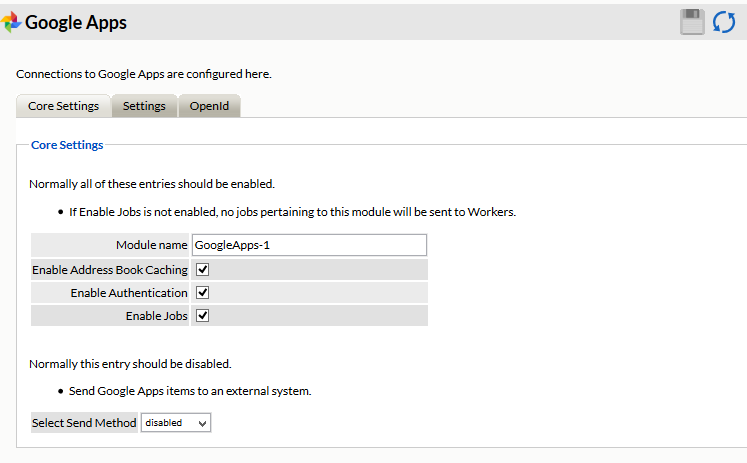
The Send Method option enables either the SMTP Forwarding or FTP features. For either feature to appear and function, the Module Forwarding tab must be configured on the Server Configuration page. See that section for more information.
Address book caching must be enabled to gather and maintain an updated list of users. Authentication is used to allow access to the Retain message store for users based on their existing Gmail account login. If the Enable Jobs option is not enabled, no jobs may be completed with the Google Apps module.
5.13.2 Settings Tab
In order to connect to the Google system, Retain requires the email address of the Admin user OAuth Service Account and a p12 Certificate for authentication. Retain archives the Gmail system through IMAP, and will login and download the message data to the Retain data store.

Test the connection to ensure that the configuration has been completed correctly.
Jobs and profiles for Gmail will not be visible until the address book has been cached. After the module has been cached, all configuration options for profiles, workers, schedules, jobs and data storage will be enabled and visible.
5.13.3 OpenID Tab
Configure the OpenId Connect tab in Retain by inputting the Client ID, the Client Secret, and the Public RetainServer URL and saving changes. NOTE: The public RetainServer URL should look something like http://<yourdomain.com>/RetainServer. Only specify to the ".../RetainServer" portion of the URL, the rest is automatically filled-in. Specifying the complete URL will result in a connection error.

If Retain has been configured with OpenId credentials, the login page will display an option to login with Google credentials. If a user is currently logged-in to their Gmail account, simply clicking the "Login with my Google account" button will automatically log them into Retain.
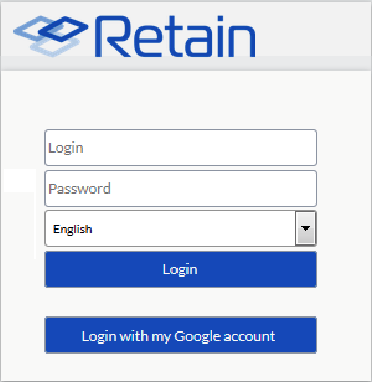
5.13.4 Google Apps Profile
To create a profile to archive email and data from Google Apps, select the add profiles button and name the profile then continue configuring as desired. The Google Apps profile must be configured and all settings saved before a job can be created and run.
5.13.5 Core Settings
The profile will not become active and will not allow jobs to be run unless the profile is enabled. Enable the profile by placing a check mark in the ‘Enable Archiving’ checkbox.

5.13.6 Message Settings
The Message Settings tab contains the source and status settings for the messages to be archived. Message types and sources which are checked will be archived in this profile.
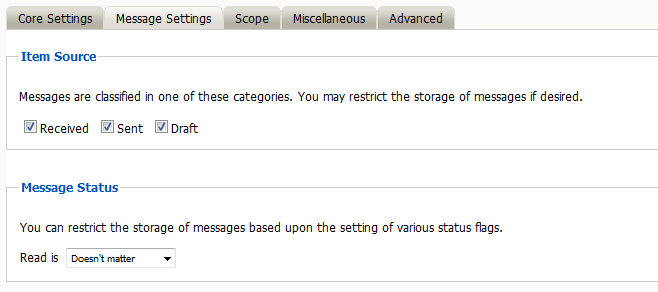
Any item type or status which is not selected or specified will exclude qualifying items from being archived in Retain.
5.13.7 Scope tab
This is the most critical tab to fill out as it sets the limits on how much to archive.
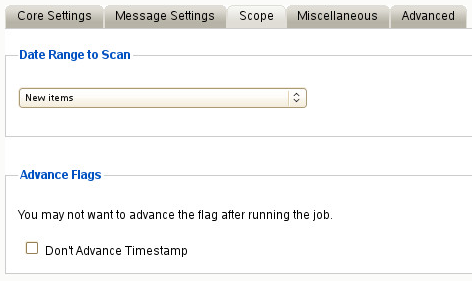
Date Range to Scan
The Date Range determines which message items are collected, depending on the date of the message.

New Items: All items that have not been archived by Retain since the last time the job ran.
All Items in Mailbox: All items in the mailbox starting from 1/1/1970, duplicates will be processed but not stored if they already exist in the Retain archive.
Number of days before job start date and newer: Only items from the relative number of days from the time the job began will be archived. E.g. messages that came into the email system 7 days ago or less.
Number of days from job start date and older: Only items previous to the relative number of days from the time the job began will be archived. E.g. messages that came into the email system 7 days ago or more.
Specify custom date range: Only items between two absolute dates will be dredged.
Specify custom date range relative to job start: Only items between two relative dates will be dredged. E.g. messages that came into the email system between 7 and 5 days ago.
Advance Flags
Enabling "Don't Advance Timestamp" will not update the timestamp flag. Items that are dredged will still be considered new by Retain the next time the job runs.
This is useful when troubleshooting, but is generally not used for normal jobs.
5.13.8 Miscellaneous tab
The miscellaneous tab allows the configuration to allow or deny archiving and indexing of attachments in Retain. If attachments are to be archived, they may also be indexed to provide searching capability in the browse messages interface.

5.13.9 Advanced tab
The advanced tab allows the administrator to be even more specific in what to archive and what to exclude. The criteria added under the ‘advanced’ tab will limit associated jobs to only the items matching the criteria. Up to 6 lines of advanced criteria may be added to each profile. Each additional line will be logically AND-ed together. For example, the system will archive all items where the following is true: Criteria A AND Criteria B AND Criteria C AND etc.
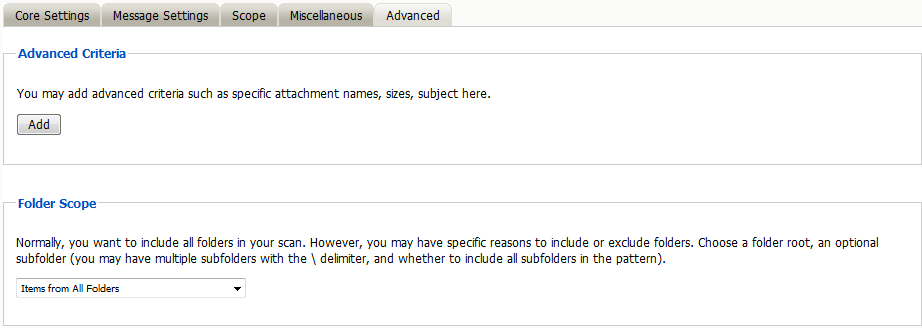
You may select based on:
-
Subject
-
Sender
-
Recipient
-
Size
-
Attachment Name

Specify the criteria, whether it is: equal to or not equal to, whether they contain or do not contain the item.
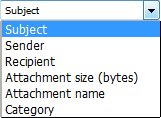

This gives you great flexibility and granularity. It allows you to customize archival jobs and retention for many different groups, or even individuals.
5.13.10 Folder Scope
By default, we dredge items from all folders. You can specify one or more inclusions or exclusions.
Your choices are:
-
Dredge everything
-
Dredge only these listed folders
-
Dredge everything except these listed folders

How to specify the list of folders to dredge/exclude:
-
Select to only get items from the list, or all except items from the list, as desired

-
Select ‘Add’ to open a new selection

-
Specify a System Folder (mandatory). Example: Calendar

-
You may specify a subfolder of that folder (optional)
Example: entering “old” would mean the folder “old” under “Calendar”
-
You can have multiple hierarchies under that with the / delimiter
Example “old/mail” would mean the subfolder “mail” under “old” under “Calendar”
-
6.You specify if the option includes subfolder
Example: If you select “old” and “includes subfolder” is unchecked, “Calendar/mail” is selected. If “includes subfolder” is checked, “Calendar/old/mail” would also be selected